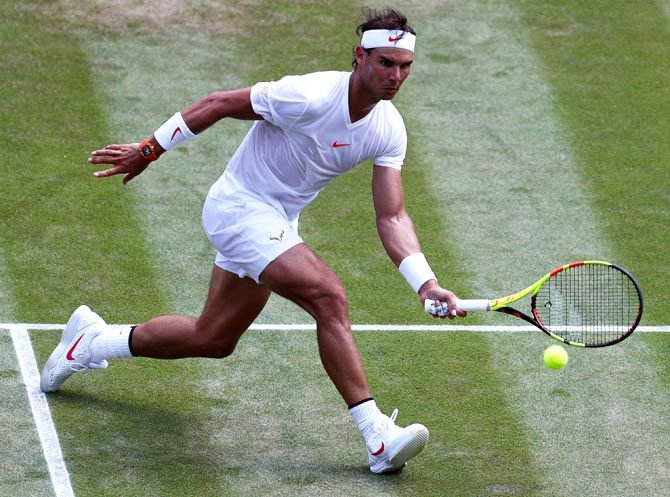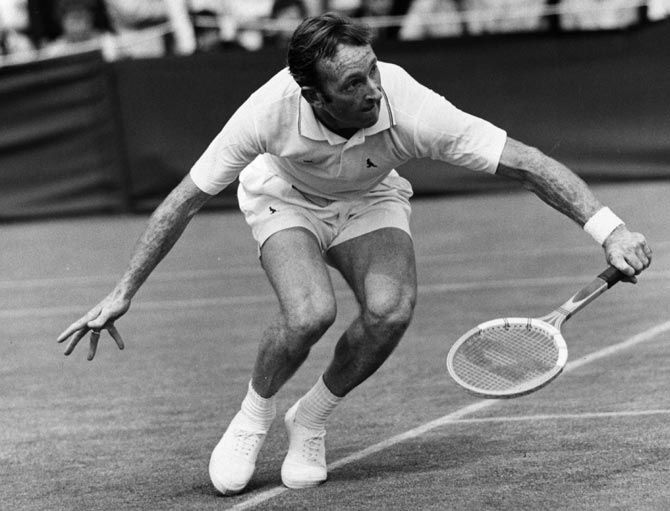 | « Back to article | Print this article |
'I don't think Rafa would have played very well on the grasscourts that we used to play on.'
Australian great Rod Laver laments that the power players can now generate on serve and the reliability of the bounce has made serve-and volley almost redundant.

Australian great Rod Laver is as impressed as anyone while watching Rafael Nadal tear into the fourth round of Wimbledon on Saturday to stay on track for a third title.
Yet Laver, who many still feel is the best player ever to have graced the All England Club lawns having won four titles in the 60s either side of being outlawed, says the marauding Spaniard would have feared grasscourt tennis in his day.
Wimbledon is no longer a fortress for serve-and-volleyers like Laver or players who came later such as Americans John McEnroe and Pete Sampras, who dominated in the 1980s and 1990s.
Changes to the grass, the hardness of the courts and racket technology now mean you can win the title from the baseline.
A look at the wear patterns on the courts this year proves that -- with the areas inside the lines still a lush green nearly halfway through the tournament and the zone around the nets virtually unmarked.
Of the 91 points Nadal won in his straight sets defeat of young Australian Alex De Minaur on Centre Court only 19 were finished off at the net.
Nadal is by no means a bad volleyer but, like most of the top players these days, he does his damage from the baseline.
Laver, who sat in the Royal Box as a guest of the club on the 50th anniversary of his return to the championships after the game turned pro, said it like watching a different sport.
"I don't think Rafa would have played very well on the grasscourts that we used to play on," Laver, who is approaching his 80th birthday, told Reuters.
"The ball kept lower and the bounce was uneven. You couldn't hit topspin like he does when you can't trust the bounce.
"We were scraping it out of the ground half the time. So no, I wouldn't have thought Rafa could have played like he does then. Roger (Federer) maybe could have done it, he could have adjusted himself.
"Wimbledon's courts were always the best but the bounce was still uneven, and the baselines were just loose dirt."
Laver says he occasionally visualises what it would be like to have played Nadal or Federer -- the two giants of the modern game who between them have won 37 Grand Slam singles titles.
"Actually I'm very happy to have played at another time," he said. "Roger and Rafa are unbelievably good players. I was playing with a wooden racket all those years. They play with the bigger headed rackets and it's so different.
"I can't even envisage playing with a racket like that. It's two different games."

Laver laments that the power players can now generate on serve and the reliability of the bounce has made serve-and volley almost redundant.
"When you can serve it down at 125 or 135mph there is no real need to go to the net," he said.
"I used to serve and volley first and second serve because you knew that it was a safer option than letting the ball bounce. It was a natural thing to do.
"If the conditions are not conducive to volleying now, why would they want to come in. Players are not really exposed to volleying now which is a shame."
Laver is no curmudgeon though and delights in watching the artistry of Federer and the brutal power of Nadal as well as young guns like compatriot Nick Kyrgios and German Alex Zverev.
He will be a regular viewer as Wimbledon enters its second week -- back at the place he returned to in 1968 after tennis opened its doors to players like him who had turned pro in order to earn a living from the game.
Laver won the calendar-year Grand Slam in 1962 before joining the professional ranks and effectively ruling himself out of five years' worth of majors.
Had it not been for his exclusion, his total of 11 Grand Slam titles would surely have been around the 20 that Federer has, perhaps more. But he has no regrets.
"No, I spent five years travelling with (Ken) Rosewall, (Lew) Hoad and (Pancho) Gonzales, and I returned in 1968 a much better player than I was in 1962," said Laver, who won the calendar year Slam for a second time in 1969.
"I stayed long enough as an amateur to prove I could win the big tournaments, and then when I turned pro I actually improved out of sight. I remember when I came back and Roy Emerson said to me 'What happened to the second serve I used to beat up on?'
"I said 'I had to get rid of that'."
